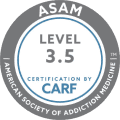The United States is facing an opioid epidemic of unprecedented scale. Opioids such as prescription painkillers, heroin, and even the synthetic opiate medications that treat opiate addiction, hold countless people—and their loved ones—in their grasp. As a mental illness, opioid addiction spares no gender, race, or socioeconomic class. According to the US Centers for Disease Control and Prevention (CDC), 136 people die every day from an opioid overdose.
In the face of this devastating epidemic, many people with opioid use disorder are highly motivated to stop using opiates, whether prescription or illicit. However, the symptoms of opioid withdrawal can be highly unpleasant and are a huge barrier for people who are looking to stop their substance abuse.
A relatively new FDA-approved medication, Lucemyra (lofexidine), is the only non-opiate medication available that supports people through withdrawal. However, it is understandable that people may be unclear about how this medication works—or concerned that Lucemyra itself might have the potential for abuse, given the track records of other medications used in opioid withdrawal, such as buprenorphine and methadone.
Read on to learn more about Lucemyra, including how it typically gets used in addiction management and whether it is a potentially addictive medication.
What is Lucemyra?
Lucemyra is the brand name for a generic medication called lofexidine. Lofexidine is in a medication class known as alpha-2 adrenergic agonists that also treat high blood pressure and anxiety. Experts believe that Lucemyra works to mitigate the effects of opioids by reducing the release of the neurotransmitter norepinephrine. According to the US Food and Drug Administration (FDA), norepinephrine has gotten implicated in several of the symptoms of opioid withdrawal. These opioid withdrawal symptoms include drug cravings, anxiety, aches and pains, muscle tension or spasms, feelings of restlessness, sweating, racing or pounding heartbeat, runny eyes, runny nose, yawning, and gastrointestinal distress.
How Long Has Lucemyra Been in Use?
The FDA approved Lucemyra in 2018. It is currently the only FDA-approved, non-opioid, non-addictive treatment that gets indicated to help relieve the typical constellation of opiate withdrawal symptoms. Lucemyra is approved to help a person with opioid use disorder through the withdrawal process so that they can continue their recovery process opiate free, potentially with the addition of medications, such as naltrexone.
How Is Lucemyra Used in Opiate Addiction?
Currently, Lucemyra gets used exclusively to help people with opioid use disorder manage the withdrawal period. The withdrawal period can be very intimidating, and many people with opioid use disorder are familiar with the experience of attempting to come off opioids but then quitting prematurely simply because they could not manage the physically uncomfortable symptoms of withdrawal.
Lucemyra is an oral pill that can be taken with or without food, at least 5 to 6 hours in between doses. Treatment with Lucemyra usually lasts for 5 to 7 days following a person’s last use of opioids; however, it can be continued for up to 14 days. A medical provider will consider a person’s withdrawal symptoms when deciding when to discontinue this medication gradually. Currently, Lucemyra can only be used in people over the age of 18, although it is being studied to see if it may be safe in a younger population (mainly in babies who are born with opiate dependencies).
It is vital to know that Lucemyra is not a treatment for opioid use disorder—it is solely indicated for use during the initial withdrawal process. It’s also important to know that after a person has been taking Lucemyra for withdrawal and their body has adapted to the absence of opiates, they will have a much lower tolerance for opiates if they begin abusing substances again. Unfortunately, that means that they may be at higher risk for an opiate overdose and death.
What Does the Research Say About Lucemyra?
Many researchers have evaluated Lucemyra and its role in helping people withdraw from opioids. For example, researchers have found that people who are opioid-dependent and treated with Lucemyra are more likely to complete medically supervised withdrawal treatment and less likely to experience severe symptoms of opioid withdrawal when compared to those who received a placebo (no treatment). Another analysis evaluated how Lucemyra compares to alternative medications used in the withdrawal period, such as decreasing doses of methadone, and found that it was comparable. However, compared to methadone, Lucemyra may be preferable for some individuals because it is a non-addictive, non-opiate medication.
What Are the Side Effects of Lucemyra?
Like any prescription medication, Lucemyra does carry the potential for side effects. Medical experts note that the most common side effects of Lucemyra include the following:
- Blood pressure that drops when going from a lying to sitting or sitting to standing position, which can often cause lightheadedness (orthostatic hypotension)
- Dizziness
- Dry mouth
- Low blood pressure independent of positional changes
- Sleep disturbances, such as insomnia
- Slow heart rate
- Tiredness or drowsiness
Less common side effects that have been reported include fainting (which occurs in less than 1% of people taking Lucemyra) and ringing in the ears (which also occurs in less than 1% of people taking Lucemyra). Additionally, an abnormal heart electrical pattern has also been observed in people taking Lucemyra, which can be dangerous or even fatal. For this reason, people who have a condition known as long QT syndrome should talk with their medical provider before considering Lucemyra for opiate withdrawal management. It is also prudent to consider any other blood pressure medications or heart medications that a person may get prescribed when considering Lucemyra to help with opioid withdrawal symptoms.
Are There Other Medications Available that Are Similar to Lucemyra?
Lucemyra is part of a class of medications (alpha2 adrenergic agonists) that have historically treated high blood pressure or anxiety. One of the most familiar medications in this class is clonidine. In addition, many people who have previously undergone treatment for opioid use disorder may be familiar with clonidine because of its off-label use to help people manage the symptoms of opiate withdrawal in acute settings (such as in a hospital emergency department or a structured rehab facility). However, one of the drawbacks of clonidine therapy is that it has the potential to lower a person’s blood pressure, potentially causing them to faint or endure other unfavorable events.
Research has shown that while Lucemyra does also have the ability to lower a person’s blood pressure, it has less of an effect on a person’s blood pressure than clonidine. For people with opioid use disorder who face the opioid withdrawal process, Lucemyra has the benefit of being just as effective as clonidine for managing withdrawal symptoms but with fewer side effects.
Is Lucemyra Addictive?
Because Lucemyra is not an opioid, it does not carry the risks of addiction that other medications used in addiction treatment do, such as buprenorphine or methadone. Simply put, experts do not believe it has any addictive potential. As added evidence, medications similar to Lucemyra, like clonidine, have been used off-label by many medical providers to help with opioid withdrawal symptoms without demonstrating a concern for abuse potential.
Other Resources for Opioid Use Disorder
Many people within the addiction world regard Lucemyra as a promising new alternative for managing opiate withdrawal symptoms, particularly because it is a non-addictive, non-opiate medication that can help people withdraw from opiates with fewer side effects than clonidine.
However, Lucemyra is not the only option for people who are motivated to stop using opiates. Many people can successfully navigate the withdrawal period with other medications as well, especially if they are undergoing withdrawal within the confines of a structured rehab setting.
Once people have withdrawn from opiates, the medication has been cleared from their system—however, the psychological dependency often persists. Lucemyra cannot help a person stay sober over the long term because it has not gotten approved as a treatment for opioid use disorder. Instead, a supportive community—such as the kind found in Narcotics Anonymous—combined with behavioral therapy and, potentially, other medications can help people with opioid use disorder seeking to break free of the cycle of opiate addiction remain sober over the long term.
Learning More About Lucemyra for Addiction Treatment
Lucemyra can be a helpful medication when a person with opioid use disorder undergoes the opiate detoxification process. Traditionally, withdrawing from opiates has been managed with medications such as buprenorphine and methadone, which are opiates themselves and, therefore, have a potential for abuse. Lucemyra can help break this cycle and be a helpful bridge toward sustained sobriety.
At The Haven New England, our medical providers are highly experienced at helping clients undergo treatment for opiate addiction most comfortably and safely possible, using medications like Lucemyra and others.
To learn more, contact us today.



